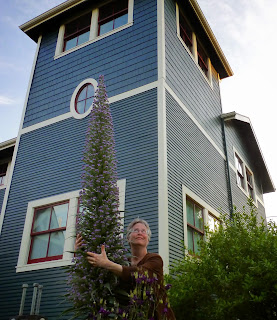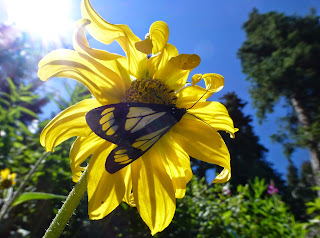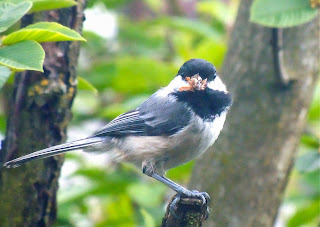There was a time when we thought Mr. Happy would never rise up, would remain just a withered stump of a thing. But we were wrong. Mr. Happy is standing up straight and proud and pink, a little disheveled around the dark curls at his base, but still a sturdy spike of glory. He’s magnificent. One look at him and you can tell he doesn’t belong here. You can hike all summer long around here and not run into another ten-foot-tall tower of flowers. The other way to tell is to remember how many days Dave had to wrap him in a blanket with a light bulb for heat and read “Charlotte’s Web” to him last winter. It ain’t natch’l.
So I’m not getting away with anything here. If I was planning to get an official certification as a Backyard Habitat, Mr. Happy would put the lie to it. It would be like trying to shoplift a refrigerator under my overcoat. People can tell.
I’ve only recently become aware why someone would want to have a certified backyard habitat. Rules aren’t stringent. Someone needs to come by and see that at least five percent of your vegetation is native to the area. Five percent. Why would anyone want to have a garden with just the same straggly stuff you could see in the local woods anyway? Glad you asked.
It’s a little lesson in evolution. Every living thing is trying to get along. Get along in life, that is, and not necessarily with each other. Definitely not with each other. It’s eat or get eaten. You have a plant that wants to eat sunlight, and a raft of caterpillars that want to eat the plant, the plant is going to have an opinion. And it’s going to back up its opinion with some chemical defenses. And sooner or later some branch of the butterfly family tree is going to do an end run around those defenses, and that’s where the eggs are going to be deposited. If the emerging caterpillars manage to chew the plants all up, then they’ve screwed themselves too. But if the birds pick off most of the caterpillars, leaving just enough of them to keep the butterfly franchise going, everyone makes out. What you are witnessing in a natural landscape is the truce that remains after everyone’s done duking it out.
This balance the plants and insects are achieving as they dance through time together can get to be pretty precise. Many butterflies are adapted to one host plant only. You start carting them out and replacing them with pretty flowers that evolved somewhere far away, you’ll find your insect population at a complete loss. You strip-mine the Midwest with Roundup so you can replace the native milkweeds with corn and soybeans, you’ll crash the monarch butterflies. They don’t have thousands of years to come up with a new plan.
This is not good news for the birds that are counting on the insect hatch to feed their own young, like
our chickadee friends, the Windowsons. It takes a whole lot of grubs to raise a baby Windowson. They’re hauling them in so fast it looks like Lucy Ricardo and Ethel Mertz doing an episode in a sausage factory. Visualize an endless chain of links pouring into the birdhouse. Your pretty new garden does not provide enough little green sausages for the bird population.
Fortunately for you, you don’t remember when there were ten times as many birds. Or ten times that many. That was in your mom’s era, or your grandma’s–might as well have been the Cretaceous. So you’re free to enjoy your exotic flowers. I know I do.
But I’m still keeping my favorite invasive species, Tater Cat, indoors, and when Mr. Happy finally shrivels up–he can’t last forever–I’ll think about slipping in a nice local flowering currant.



Given that a "bird" may be loosely defined as a natural mechanism for converting bugs into guano and depositing it on cars, I'm not sure that ten times as many of them would qualify as an undiluted blessing. Still, your overall point is well taken. We have to live, but we have to make sure that the disruptions we cause are not too damaging to the systems we still depend on.
In any case, the ecosystem will get its chance to recover after another thirty or forty years. Humans will all have migrated to virtual reality.
Oh, and Mr. Happy is a magnificent specimen well deserving of pride, even if some killjoys might think he's been placed somewhere "against nature". Discrimination in the issuance of Backyard Habitat certifications is clearly an issue that needs to be addressed, even if old-fashioned thinkers object that "traditional habitat" is being redefined.
Next time I'm going to plant a couple boxwoods just at his base and trim them appropriately.
And I'm afraid the ecosystem will recover without about ninety percent of what's in it now.
Does it count if one's plantings support the local deer population? Our poor rhododendron hasn't had more than one or two blooms on it for years now and this spring we had one crocus survive for one day … Meanwhile, the deer amble down the streets like teenagers on a Friday night, bunching into each other and peering into the car …
Back to the question: how do I know if our backyard is good for wildlife other than deer? Any websites to recommend?
http://www.nwf.org/How-to-Help/Garden-for-Wildlife/Create-a-Habitat.aspx
Thank you, Marilyn – just what I hoped for.
Me too! Thanks Marilyn!
Yes. And I strongly suspect that our world would adapt very well to the absence of our important selves if something Monsantoed us out…
It'd be a heap better off for sure, but it might take another billion years to start looking lively again.
I am currently in LA where my daughter just had surgery. It's interesting listening to all the talk and radio discussions on the drought. There is actually a shortage of native plants in nurseries here because so many people are replacing lawns with what should be in a desert. Progress! I hope it will help though, since the drought is really severe and shows no signs of ending. Not enough snowmelt.
I'm not much of a capitalist, but if we charged for things what they really cost us–charged for water as though it were precious, rare, and necessary–charged for oil and coal and gas enough to mitigate their harm, and that's a lot–we'd see some things change in a bigger hurry.
My goodness, Mr Happy did indeed rise to the occasion! You know, what with the tower and all, there's a pronounced verticality theme over there at the Murr residence.
Until you meet Murr…ha!
Hey. HEY. Pootie and I just need to be here to counterbalance the Daveicality.
I built my house in a woods of white pine, clearing minimally. Hurricane Irene dropped four trees on the house while I was in it, and mangled a lot of the rest of it. So now I'm in a three-acre clearing, with opportunistic plants fighting each other. I watch. That's my idea of gardening. When I first cleared, I counted the rings on the biggest tree, and I was older than it, so it was a pasture before the pines, and something else before then. If something looks evil, I go after it, but generally I stand off. Quite a show, and a changing one.
Our cabin is in a thick stand of Doug fir (mostly) and when one goes down it tends to bring its friends with it. We had three 100+ foot trees land on our deck and barely clip the house, one right on top of the next. I will no longer stay there on a rainy windy day.
What *is* Mr Happy? I can't tell from the picture;perhaps an Echium?
Our yard looks a scruffy mess and I'm happy to report that the spiders, moths, butterflies, bees, beetles, lizards, birds all seem rampantly reproductive.
Echium, ding ding ding!
I soo envy your ability to give us much needed messages channeled through laughter. We tend to forget that we, too are part of the web of life and we may also be a species that becomes extinct if we don't stop this huge extinction of species.
If I didn't laugh so much I'd have to cry more. I have my preferences! And yes–our days are numbered, as a species. It's a damn shame we're taking everyone else with us.
"The Rise of Mr. Happy" sent my mind off in a totally different direction!! I mean, you usually do head a bit off the beaten path, occasionally off your mind!
and now waiting to hear how Pat L and Roxie will respond!
You are welcome to follow my mind, but mind the alleyways.
Oh Rose, you used to be such a sweet innocent! I see now what a steady diet of Murr will stir up in a person's mind. In your agitated state, I suppose that next you'll be suggesting she uses such phrasing on purpose!
All right, Pat, that was truly a LOL moment for me.
Why wait? Slip in the nice local flowering currant now, I'm sure you'll find a spot for it and the birds will love you. Word will spread about the "new bird restaurant at Murr's", and a few years from now you can do the birdwatch marathon simply by looking out your window.
What type of plant is Mr Happy? I'm sure you've told us before but I've forgotten.
Echium. And I did plant a flowering currant last year. It's really pretty big now already, but it FAILED TO FLOWER. I don't know why. This spring I planted a twinspur and a mock orange and a ninebark and a fringe cup and a milkweed, all native. I'm working on it!
And not ten minutes ago, I reinforced "no Roundup" for the umpteenth time with a landscaper. Ignore WHO: it's mother's milk, apparently. Also just planted a ninebark, but already it is whining. Southern exposure? No Netflix? You'll have to weave the progress of yours into a future post, between bleak snorts.
So far, except for the non-flowering thing, they're all rampaging away with minimum care. I guess that's another one of the benefits. Your ninebark maybe got stomped by a horse?
Mr. Happy would be Mr. Impossible in these parts.
I would have thought the same thing. In a sensible world, he would be impossible here. Pretty sure he's done now, and won't flower again, so there will be no more winter rescues with the light bulb.
Amen!
My baby's gone religious.
Thoughtfully amusing and oh so true.
I'm glad you have your corner of the state going strong.
Pearl
Me and Mr. Happy, you mean.
I knew this fellow that had, in fact, named his red-headed friend, "Mr. Happy." You know why men name their penises, don't you? Because they don't want a total stranger telling them what to do all the time.
AR AR AR AR AR AR AR AR